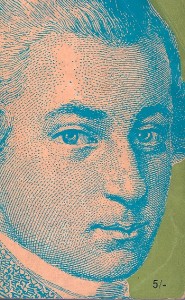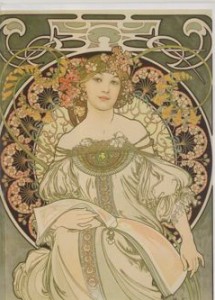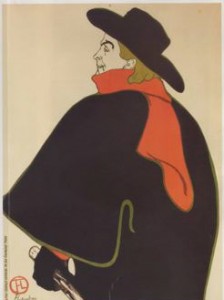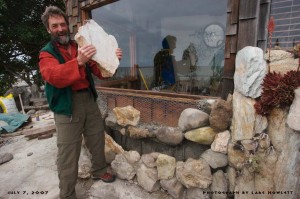Merry Christmas & Happy New Year from everyone here.
Creaturemag is an online arts and culture magazine Released Sporadically. Visit www.creaturemag.com for more info.

Created by June Morrall
Merry Christmas & Happy New Year from everyone here.
Creaturemag is an online arts and culture magazine Released Sporadically. Visit www.creaturemag.com for more info.
By June Morrall
You don’t have to live on historic Johnston Street in Half Moon Bay – or be born into one of the pioneer families – to fall in love with the fascinating history of San Mateo County’s oldest town.
Johnston Street, east of the colorful shops on Main Street, presents a seductive introduction to the charms of old Half Moon Bay, a close-knit village known as “Spanishtown” over 100 years ago.
History is inescapable on Johnston Street. In brief, at 505 Johnston Street, the Spanishtown Historical Society operates a quaint museum in what was formerly the town’s two-cell jailhouse. Behind the museum you’ll find the “Thomas Johnston Barn,” filled with antique agricultural implements that help tell the story of farming on the Coastside.
A few paces to the south stands the strikingly beautiful Methodist-Episcopal Church built in 1872 and listed on the National Register of Historic Places.
While Johnston Street was where old Half Moon Bay’s political and business elite chose to live, their homes were not the fairy tale castles we associate with the rich and powerful from “over the hill” in Burlingame and Hillsborough.
In case you’re wondering how Johnston Street found its name, here’s a brief history of that pioneer family. Born in Scotland in 1813, James Johnston came to America as a child. During the Gold Rush he acquired 1, 162 acres from the Miramontes family, land close to the village now known as Half Moon Bay. At the time the Spanish called it “San Benito,” but to the Yankees it was “Spanishtown.”
James built the interesting New England-style “saltbox farmhouse” on a slope overlooking the romantic Pacific for his Spanish bride, Petra Maria de Jara. On the second floor there was a small chapel, and the walled garden and separate cookhouse are said to reflect the influence of Johnston’s wife.
When it was new, the house was painted white. Known as the “White House,” it became the center of social and cultural activities of the day. James and Petra came to symbolize the successful melding of the Yankee and Spanish communities.
James Johnston stocked his ranch with dairy cattle driven west from Ohio by his brothers Thomas and William. Thomas Johnston operated a fast freight business out of the restored barn now directly behind the Spanishtown Historical Society’s museum.
Story by Michaele Benedict
A Love Affair with Mozart
 Mozart and I have been spending two or three hours together every day for the past two months. Sometimes I grumble at these meetings. I have been known to swear. But I have never failed to show up, and I am never bored. I love Mozart more now than I did when I knew him less intimately.
Mozart and I have been spending two or three hours together every day for the past two months. Sometimes I grumble at these meetings. I have been known to swear. But I have never failed to show up, and I am never bored. I love Mozart more now than I did when I knew him less intimately.
On Saturday, Feb. 7, I am supposed to play the solo part in Mozart’s Piano Concerto No. 21 in C Major, Köchel 467, with the Coastside Community Orchestra in their winter concert at the Community Methodist Church in Half Moon Bay. My part is about 50 pages long and takes about 25 minutes to play if you don’t stop.
Although I have been getting paid for playing the piano since I was 13 and had my first church job, I have never played anything as long, as exposed, or as difficult as a Mozart piano concerto. I got the job when the orchestra decided it wanted to do a piano concerto and two likely soloists politely declined to perform without pay. I am the orchestra’s regular pianist; it is a volunteer orchestra, and if they ask me to play, I have to do it. Usually I enjoy it.
In this case, my confidence was not boosted by the reaction of two musician friends when I told them about the concerto. “What? WHAT?” one of them said. “Oh, dear!” another one said. That made me mad, so I practiced so long and so hard that I worked myself into a disastrous muscle spasm and had to go to the doctor.
You may know Mozart from the film “Amadeus”, which was a singular allegory about the nature of musical genius but which wasn’t very true to history. In February, 1785, when Concerto 21 was written, Mozart was married to the dippy Constanze, whom he adored, and had a year-old son, Karl Thomas, one of his two surviving children. He had presented six string quartets to Joseph Haydn, who considered Mozart the greatest composer he had ever known. He was short of money as always, though he lived well and had a special affection for gold buttons on his jackets. He was 29 years old and had only six more years to live.
As one studies a major work like the piano concerto, things begin to reveal themselves which are not obvious from listening to recordings, or even from playing through the work the first dozen times. My first realization, of course, was that when you are mad, scared, or unconfident, it is difficult if not impossible to play Mozart.
The second and happier realization was that this particular concerto is truly play…as in play the piano, not work the piano. The conversation between the orchestra and the solo instrument is so lighthearted and joyful that the player cannot help but join the party.
Lesson three: You cannot read music when you are crying. The slow movement of this piano concerto, which is sometimes called the “Elvira Madigan” because it was used in an old Swedish movie of that name, pulls at the heartstrings, and it does it every time. Fish up a performance of the Andante on YouTube or iTunes and see if it doesn’t get you.
The entire work is like a little opera, but to tell you more would be against the whole premise of classical music, where you get to create your own plot as you like. I can only say that Mozart, who could sometimes be coarse or unkind in his everyday life, is angelic in his music; in this, the film “Amadeus” was absolutely true.
Who could fail to love someone who saw and wrote so convincingly about a finer, brighter world than the one we live in? It is more than 200 years since Mozart walked the earth, but the power of his vision has remained undimmed. What a privilege to get to play one of his major works. I hope I don’t make too many mistakes.
——-
Michaele Benedict lives in Montara.
Her most book is called “Searching for Anna,” for more information, please click here
[In my mailbox. Peter Adams, you will love this.]
Sign of the Times?
Rare & Important Art Nouveau Posters. Swann Galleries. For more information, please click here
 (Alphonse Mucha, “Reverie,” 1897.)
(Alphonse Mucha, “Reverie,” 1897.)
 (Henri de Toulouse-Lautrec, “Artistide Bruant Dans Son Cabaret,” 1893.)
(Henri de Toulouse-Lautrec, “Artistide Bruant Dans Son Cabaret,” 1893.)
There are many more delightful posters
I am glad to announce that the 3rd issue of mgv2>datura is now online featuring:
Daniel Y. Harris – David Fraser – Alex Galper – Taylor Graham – Steven F. Klepetar – Chris Major – Srinjay Chakravarti – Tendai R Mwanaka – Jan Oskar Hansen – Cover ans inside illustrations: Norman Olson
You can read this new issue at mgversion2.free.fr in the B-side, Current issue
Kind Regards
To go directly to the current issue of poetry, please click here
 Dear friends & family who are joining in for the “Crossing Patagonia Expedition” next month, & to those of you who are interested in what we are attempting to do there, I invite you to go to your computer & Google: 180 South ...to see this pretty well made, fast-paced, rockin’ soundtrack film featuring Yvon Chouinard, founder of the clothing company Patagonia, & friends adventuring around the wild south of Chile. It got me excited & reminded me of the very real potential we will have to bring back some great footage & hammer it into a truly worthwhile film that we can hopefully all be proud to have been a part of…
Dear friends & family who are joining in for the “Crossing Patagonia Expedition” next month, & to those of you who are interested in what we are attempting to do there, I invite you to go to your computer & Google: 180 South ...to see this pretty well made, fast-paced, rockin’ soundtrack film featuring Yvon Chouinard, founder of the clothing company Patagonia, & friends adventuring around the wild south of Chile. It got me excited & reminded me of the very real potential we will have to bring back some great footage & hammer it into a truly worthwhile film that we can hopefully all be proud to have been a part of…
Abrazos, Michael (Powers)
Story by Peter Adams
orville — he was singular! i am sorry he’s gone. here’s one story:
we arm wrestled at the miramar beach inn during the days of joe the bartender and his ‘secret sauce’. i won, much to the dismay of orville — he was livid and subsequent threats lasted for a few weeks. upon their dissipation, we became bar buddies again. my largest regret from that episode was that i took off my favorite ring [similar to c.g. jung’s gnostic ring] and forgot to put it back on after such an intense match — orville was a very strong lad!
…have attached a photo of me and my birthday present
Story by Collin Tiura
Oh yes, I knew Orville,
He was a ding bat to be sure but an okay ding bat.
At one time he was one of the divers at Marine World when it was in San Carlos. He and another friend of mine, Ted Pinerelli, dove on fish gathering expeditions around the world, collecting specimens of the oceans. What a cool life.
When not plying the seas their work was a bit more mundane, swimming among fish in the viewing tanks.
One of the favorite chores was feeding the fish and turtles.
Ted told me this story about Orville:
Orville’s family was visiting Marine World and Ted was walking them through the park, the highlight being, watching Orville feed the fish. The spectator area was fairly crowded but all of Orville’s family was able to get an “up close to the window viewing spot”, mom, dad and the siblings.
As Orville swam along giving hand-outs to the hungry salt-water stars he came upon his clan, and proceeded to put on a special show of extended feeding in their viewing area but unfortunately forgetting rule #1 in the ‘fish feeding manual’, which was ‘always keep moving while feeding the fish’.
Maybe he didn’t forget that rule, but possibly wasn’t told ‘why’ not to stop and visit, or show off just a bit for that special audience.
So, Ted and Orville’s family are watching the show. Orville’s father apparently was a thoughtful sort of a guy not prone to show much emotion, so when a huge turtle came up behind becalmed Orville and bit one of his ears off (not quite off, it was swinging, held on by a thread or something) and blood was seriously clouding up the water to the point where you could no longer see the look of concern on Orville’s face. Ted said that Orville’s dad looked at the scene for a few seconds and then moved on to clearer water as if not at all impressed with Orville’s display, planned or not.
Ted said that Orville’s mother and siblings showed enough emotion with their screaming to more than make up for dad.
Orville’s selection of attire was farmer John bib overalls. I don’t remember seeing him wearing anything else, although he might have. And he always reeked of ‘Ben-Gay’ or some other obnoxious smelling muscle relaxing ointment, to the point where your eyes burnt if within 20 feet of him. He always had plenty of room at a crowded bar, which brings me to another ‘Orville-ism’.
I was having beers with a few of my friends at Dan’s in Moss Beach a bunch of years ago when Orville came in. He ordered a beer, and at some point we all went outside for reasons unknown. I believe we were all having a good time, but while outside Orville challenged one of my friends to arm wrestle. We all wondered where that came from but they went at it anyway. After awhile my friend had second thoughts about the whole thing and punched Orville in the nose. It was about time. We all went back in Dan’s and had another cold beer, listening to Orville repeating ‘why’d you punch me in the nose?’.
I liked Orville in a way I like many of the other coastal goof-balls. They are what they are and that’s pretty honest.
Like my Mom used to say, you ‘like them in spite of their faults not because of them’.
I was genuinely saddened when I heard that Orville had done himself in many years ago.
Mom also used to say ‘a smile is like a lighted window, it always show’s somebody’s home’ but she would describe some with ‘the lights are on but nobody’s home’. Go figure.
Well, I hope this sheds some light on things.
Sincerely, I think………………Collin
Elaine M. Teixeira: I’ve attached a copy of a photo from my class reunion, 60th, from HMB, class of ’49, oh so many years ago.
The 1949 graduating class of HMB High School held a reunion on Sept. 13, 2008 at the Mezza Luna Restaurant in Princeton-By-The-Sea. Of the graduating class of 24 students, eight attend the dinner with spouses and relations were: Ugo Lea, Frank Ramacciotti, Guido Santini, Fred Cunha, Wiulbur Azevedo, Lena Ghilardi Ormonde, Jack Bettencourt, Dick Picchi, & Elaine Martini Teixeira. Others attending: Loretta Martini Santini, spouse of Guido Santini, Stacy Teixeira, Sunnyvale,daughter of Elaine Teixeira, Sally Lea, spouse of Ugo Lea, Franka Ramacciotti, spouse of Frank Ramacciotti, John Cunha, son of Fred Cunha, Cecilia Madonna Azevedo, spouse of Wilbur Azevedo, Kenny Ormonde, spouse of Lina Ormonde, Bobbie Pacheco, daughter of La Verne Pacheco, HMB.
Members of the class who were unable to attend: Rosina Bertolucci Banks of Washington, Mildred Jepsen Evangelho, San Jose, Dolores Evangelho Sima, Fremont, Pedro Corral of Rancho Cordova, Alice Martini Wickersham, Cloverdale, Shirley Marsh Pacecho and spouse Walter, HMB. Additionally, Class Advisor, Flora Mancebo of Novato, sent her regrets, she was not able to attend due to health problems.
Those deceased: Jerry Dutton, Nataline Giusti O’Toole, Edward Kochever, Edward Marsh, Evelyn Matteucci Mason, Alice McNulty Fernari, Alan Pederson, Francis Powell, Wayne Robertson, and June Torre. Others who attend school with the Class of “48, deceased: Mateo Pacheco and Darlene Paxton Cunha.
Entertainment was provided by Fred (Fritz) Cunha, with his repertoire of jokes, and Guido Santini with a special “crutch” given to him for assistance in his advancing age!
After a delicious dinner, the class members spent time recalling their days in high school, and having many laughs. In addition, a couple of class songs were song! Among diners who came and joined the group for a few words, included local residents Gino Lea, Sharon Bertolucci, and Cherie Torre.
May fond memories of the evening sustain us until the next reunion!